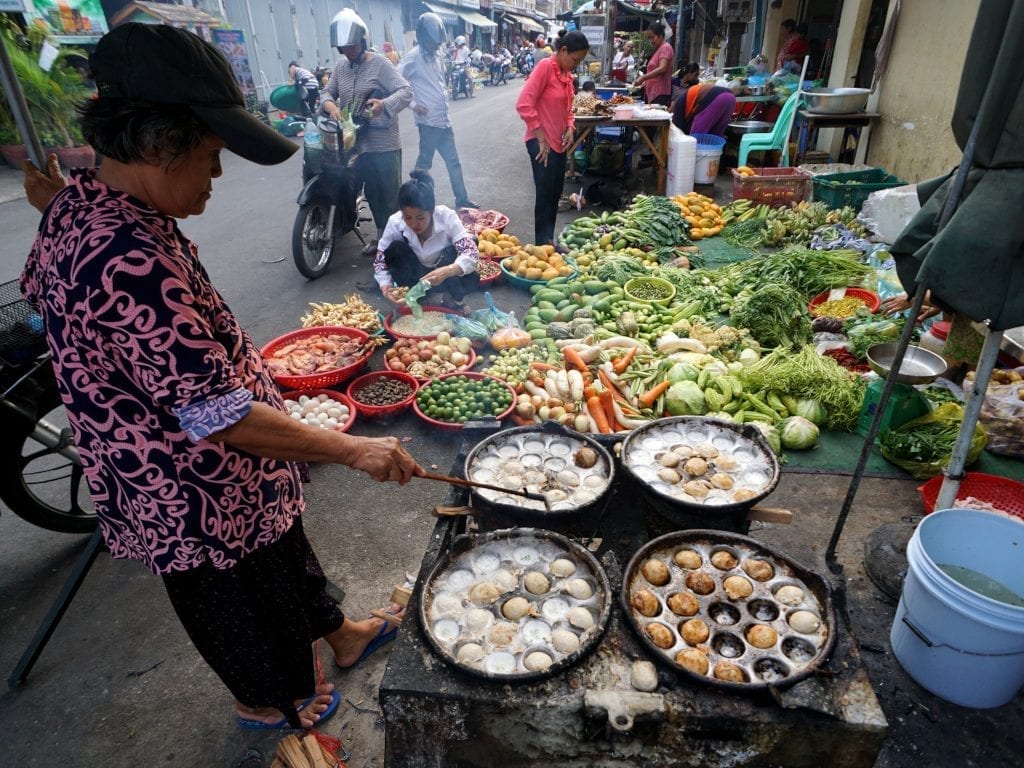Cambodian Food
Cambodians love to graze, which means snacks are readily at hand. Street food is common across the country, with vendors pushing carts selling everything from sun-baked clams and num kachay (chive cakes), to chet chien (deep-fried bananas) and num banh chok (Khmer noodles).
The aroma of local herbs and spices float from markets, and street-side stalls are set up on pavements at breakfast, lunch and dinner time, when Cambodians gather to eat at mobile metal tables and miniature plastic chairs.
Unlike its neighbours, where dishes tend to pack a real punch, Cambodian food is subtler with its spices
Cambodian food may not sit up there globally with the cuisine from neighbouring Thailand and Vietnam, but it’s slowly earning its place. Unlike its neighbours, where dishes tend to pack a real punch, Cambodian food is subtler with its spices.
Key ingredients include galangal, garlic, lemongrass, kaffir lime leaves and turmeric. These are commonly ground into a paste, called kroeung, and used as a base for cooking. Spice is usually added with dipping sauces featuring chopped chilli and garlic with fish or soy sauce, or black pepper (preferably Kampot pepper) with squeezed fresh lime.
Prahok and RIce
Prahok also features heavily in Cambodian dishes. The crushed, salted and fermented fish paste is mainly used to season dishes but can also be eaten as a main course – be warned, this is not to be taken lightly. Having earned itself the nickname of Cambodia cheese, prahok is famous for its distinct taste and pungent smell.
The Khmer phrase for eating – “nyam bai” – literally translates as “eat rice”
Rice forms a staple in local diets. Cambodia is primarily a patchwork quilt of paddies and even the Khmer phrase for eating – “nyam bai” – literally translates as “eat rice”. Rice in some form features in every meal, from the popular breakfast dish of bobor (rice porridge) and kuy teav (rice-noodle soup), to nom banh chok, made from thin rice noodles.


Cambodia Food Tours
A contemporary form of Cambodian cuisine is also starting to rise from kitchens in restaurants in the urban hubs of Phnom Penh, Siem Reap, Battambang, Kampot and Kep. Between 1975 and 1979, an estimated quarter of the population perished under the Khmer Rouge. Passed down orally through generations, many Khmer traditions, including recipes, were almost lost.
Recent years have seen Cambodian cuisine given a refreshing contemporary twist. The revival has been led by Cambodian master chef Luu Meng, and his creative interpretations can be tasted at Malis restaurants in Phnom Penh and Siem Reap. Award-winning Cuisine Wat Damnak made a name for itself in Siem Reap with its dishes that fuse the finest flavours of France with Cambodia. Covid forced it to close its doors and relocate to Phnom Penh, but its Siem Reap base is slated to reopen in October 2022. The Fishmarket Kampot serves up plates that are as easy on the eye as they are on the stomach, coupled with idyllic views of Kampot River.
Again, Cambodia’s cuisine can be explored through several tasty tours. Siem Reap Food Tours and its sister venture Phnom Penh Food Tours introduce guests to market life, back street cooking and a wide variety of street food. Kek Soon takes guests to her favourite local food spots in her hometown of Kampot with her culinary and culture tours. And Le Table Khmer restaurant’s cooking classes teach guests how to cook classic dishes, such as spring rolls and fish amok.